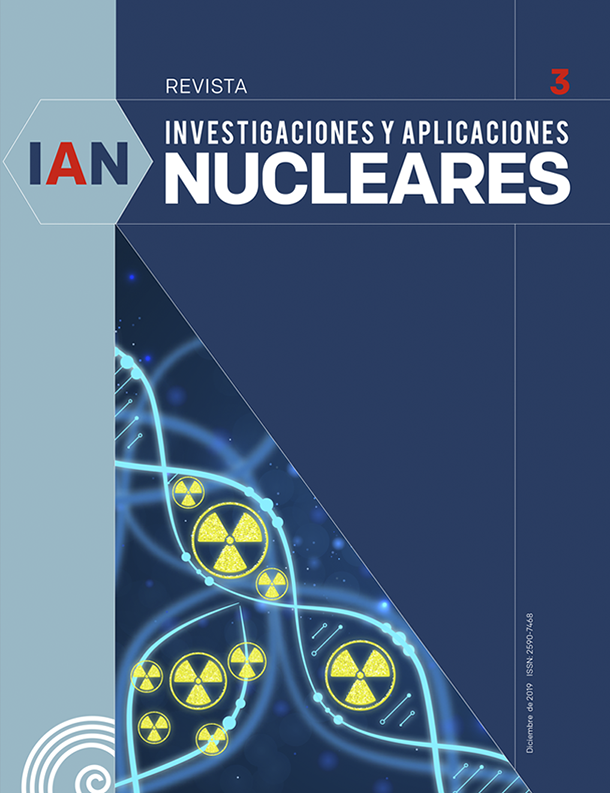Simulation of the gadolinium neutron capture reaction using Geant4
DOI:
https://doi.org/10.32685/2590-7468/invapnuclear.3.2019.508Keywords:
gadolinium, neutron capture, Auger electrons, LETDownloads
How to Cite
Issue
Section
Published
Abstract
The use of gadolinium nuclides as neutron capture agents in neutron capture cancer therapy is of great interest, mainly because of these nuclides’ high cross-section of 225,000 barns. The final state spectrum of the reaction contains gadolinium-158 (Gd-158), photon emission (X-rays and gamma rays) and electrons (internal conversion and Auger electrons). This spectrum offers very rich physics and enormous potential for the elimination of tumor cells due to high linear energy transfer. In this article, we present simulations of this process performed using the last six versions of Geant4 (10.00.p04, 10.01.p03, 10.02.p03, 10.03.p03, 10.04.p03 and 10.05.p01). Given that we are particularly interested in low-energy neutrons (energies <20 MeV) in this work, we used the G4NeutronHP package. Finally, we obtained the event count, the average energy and the angular distributions (theta and phi) of particles in the final state and find that for low-energy neutrons, study of the neutron capture reaction by Gd-158 with Geant4 is viable.
References
.[1] H. J. Taylor y M. Goldhaber, “Detection of nuclear disintegration in a photographic emulsion [2]”, Nature, vol. 135, n.° 3409. Nature Publishing Group, p. 341, 1935. https://doi.org/10.1038/135341a0
.[2] G. Locher, “Biological effects and therapeutic possibilities”, The American Journal of Roentgenology, vol. 36, pp. 1-13, 1936.
.[3] G. A. Miller Jr., N. E. Hertel, B. W. Wehring y J. L. Horton, “Gadolinium neutron capture therapy”, Nuclear Technology, vol. 103, n.° 3, pp. 320-331, 1993. https://doi.org/10.13182/NT93-A34855
.[4] A. Deagostino et al., “Insights into the use of gadolinium and gadolinium/boron-based agents in imaging-guided neutron capture therapy applications”, Future Medicinal Chemistry, vol. 8, n.° 8, pp. 899-917, 2016. https://doi.org/10.4155/fmc-2016-0022
.[5] J. T. Masiakowski, J. L. Horton y L. J. Peters, “Gadolinium neutron capture therapy for brain tumors: A computer study”, Medical Physics, vol. 19, n.° 5, pp. 1277-1284, 1992. https://doi.org/10.1118/1.596761
.[6] G. De Stasio et al., “Gadolinium in human glioblastoma cells for gadolinium neutron capture therapy”, Cancer Research, vol. 61, n.° 10, pp. 4272-4277, 2001.
.[7] T. Goorley y H. Nikjoo, “Electron and photon spectra for three gadolinium-based cancer therapy approaches”, Radiation Research, vol. 154, n.° 5, pp. 556-563, 2000. https://doi.org/10.1667/0033-7587(2000)154[0556:EAPSFT]2.0.CO;2
.[8] S. A. Enger, V. Giusti, M.-A. Fortin y H. Lundqvist, “Dosimetry for gadolinium neutron capture therapy (Gd-NCT)”, Radiation Measurements, vol. 59, pp. 233-240, 2013. https://doi.org/10.1016/j.radmeas.2013.05.009
.[9] J. Stepanek, “Emission spectra of gadolinium-158”, Medical Physics, vol. 30, n.° 1, pp. 41-43, 2003. https://doi.org/10.1118/1.1528176
.[10] B. N. Fasni, Y. Sardjono y B. P. Lapanporo, “Dose analysis of gadolinium neutron capture therapy (GdNCT) on cancer using SHIELD-HIT12A”, ASEAN Journal on Science & Technology for Development, vol. 35, n.° 3, pp. 209-212, 2018. https://doi.org/10.29037/ajstd.543
.[11] Y. Sakurai y T. Kobayashi, “Experimental verification of the nuclear data of gadolinium for neutron capture theray”, Journal of Nuclear Science and Technology, vol. 39, n.° sup2, pp. 1294-1297, 2002. https://doi.org/10.1080/00223131.2002.10875341
.[12] P. Kandlakunta, L. Cao y P. Mulligan, “Measurement of internal conversion electrons from Gd neutron capture”, Nuclear Instruments and Methods in Physics Research A, vol. 705, pp. 36-41, 2013. https://doi.org/10.1016/j.nima.2012.12.077
.[13] S. Agostinelli et al., “Geant4: a simulation toolkit”, Nuclear Instruments and Methods in Physics Research A, vol. 506, n.° 3, pp. 250-303, 2003. https://doi.org/10.1016/S0168-9002(03)01368-8
.[14] GEANT4 Collaboration, Book for application developers, release 10.5 March 2019. Disponible en http://geant4-userdoc.web.cern.ch/geant4-userdoc/UsersGuides/ForApplicationDeveloper/BackupVersions/V10.5-2.0/fo/BookForApplicationDevelopers.pdf
.[15] G. A. Miller Jr., N. E. Hertel, B. W. Wehring y J. L. Horton, “Gadolinium neutron capture therapy”, Nuclear Technology, vol. 103, n.° 3, pp. 320-331, 1993. https://doi.org/10.13182/NT93-A34855
.[16] Iwa Ou et al., Measurement of the energy, multiplicity and angular correlation of -rays from the thermal neutron capture reaction Gd(n, ) using JPARC-ANNRI”, AIP Conference Proceedings 1594, 351, 2014. https://doi.org/10.1063/1.4874094







